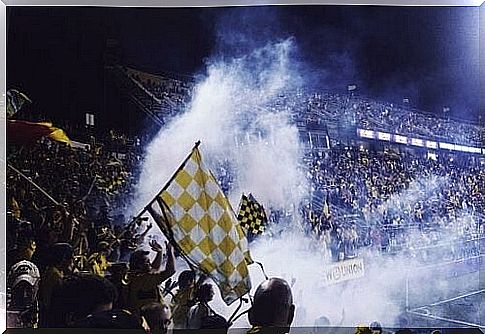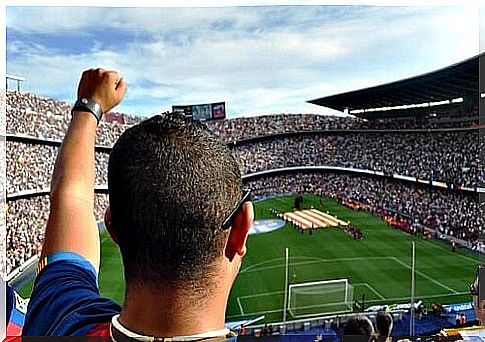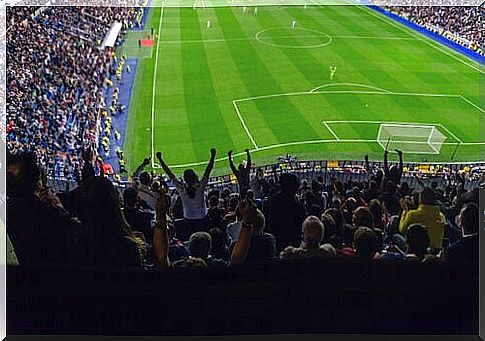Violence In Football: What Is It Due To?

Why is there so much violence in football? In particular, among the fans? Too often we read in the newspapers or see images of armed clashes between rival supporters. One of the worst episodes of violence in football took place during the final of the Libertadores Cup between the Argentine teams of River Plate and Boca Juniors, then played in Madrid, on a neutral pitch.
The importance of the teams and the scenario has been talking about this topic for weeks. Yet violence in football is present at all levels, from youth football fields to the tiers of Serie A or the Champions League. And it concerns a lot of clashes between fans, such as threats and intimidation against teams and players, as well as episodes of racism as recently happened to the Napoli player, Koulibaly.
Many people show perplexity and amazement towards these collective behaviors and do not understand the reasons for so much hatred. Well, psychology has been studying the social behavior of groups for years and in this article we will try to shed light on what lies behind these very frequent episodes that have nothing to do with sport.
Violence in football and motivations
Deindividuation
There is no single theory capable of summarizing all the triggers of violence in football. But in order to uncover the reasons for these violent and aggressive behaviors, we must first step back and explain what deindividuation is.
It is a basic concept of social psychology that will help to better understand how the behavior of people within social groups works.

Imagine you are watching a football match and a player from the opposing team is near you. If you feel like insulting him but are surrounded by fans of the opposing team, you will almost certainly choose to shut up. Now, what would happen if you were surrounded by fans of your own team?
If the fans surrounding you belong to the same team and they too are intent on insulting the rival, you will eventually end up verbally attacking the player of the opposing team. What is the difference between the two situations? Anonymity and responsibility.
As psychologists Moral, Gómez and Canto (2004) point out, “In these situations, anonymity, group and reduced individual self-awareness lead people to have impulsive, uninhibited and illegal behaviors”.
If you feel protected within group anonymity, you are more likely to commit violent actions. Nobody will know that it was we who insulted the player, so our possible guilt is hidden, spread, distributed among all the members of the group. Self-awareness decreases and responsibilities are transferred to the group. We stop being ourselves and become the group, coming to think “it wasn’t me, but the group”.
Conformism
Having talked about deindividuation, let’s now see what is meant by conformism. This is also a process that could explain the violence in football. It consists in modifying the response of an individual that comes close to that expressed by the majority.
It occurs when one’s behavior changes to match the prevailing behavior of the group.
As psychologists Paez and Campos (2003) point out, “conformism is the change in beliefs or behaviors due to pressure from a group, which changes the subject’s previous dispositions in the direction of the standard set by the group in question.”
There are several rules within a group, including:
- the descriptive norm : it refers to how one acts within the group.
- the prescriptive norm : it alludes to how the group must act.
Conformity is a normative influence, as the individual is prompted to change his personal behavior to suit that of the group. He is even capable of adopting attitudes totally contrary to those shown as a single.
If the target group acts violently, one is inclined to follow it. This conformism increases as the levels of control of the group over their members and the interdependence between them increase. It also grows when there is some uncertainty or ambiguity; when you don’t know what to do, you follow the group.
But conformity also increases when there is similarity between the group and the individual. If a person feels very identified with a football team and with the violent ideology of a group of ultras, he will almost feel compelled to perpetrate violence.

Final reflections
Violence in football is a reality that we experience too often. Unfortunately, excessive expectations in external stimuli force many people to delegate their happiness to events such as a football match.
If you have not received an adequate education and are used to resolving differences through the use of violence, it will not be difficult for you to act aggressively in the face of even a trivial disagreement. A correct and respectful education towards others is an important basis for preventing these actions.
A rich inner world and an open and reflective mind will also give you strength in yourself and reduce the need to be part of a group. Behind this need, many times there is a lack of self-esteem that we try to alleviate and hide in the crowd.
The feeling of belonging also offers a feeling of emotional fullness, so personal fulfillment that has not been developed internally is sought out.
Getting to know yourself will be essential to avoid joining groups that can communicate only through violence. The lower one’s self-esteem, the stronger the desire to belong to a group will be.
If we all have the ability and strength to respect ourselves and others, violence in stadiums and football will soon be a bad thing of the past.









